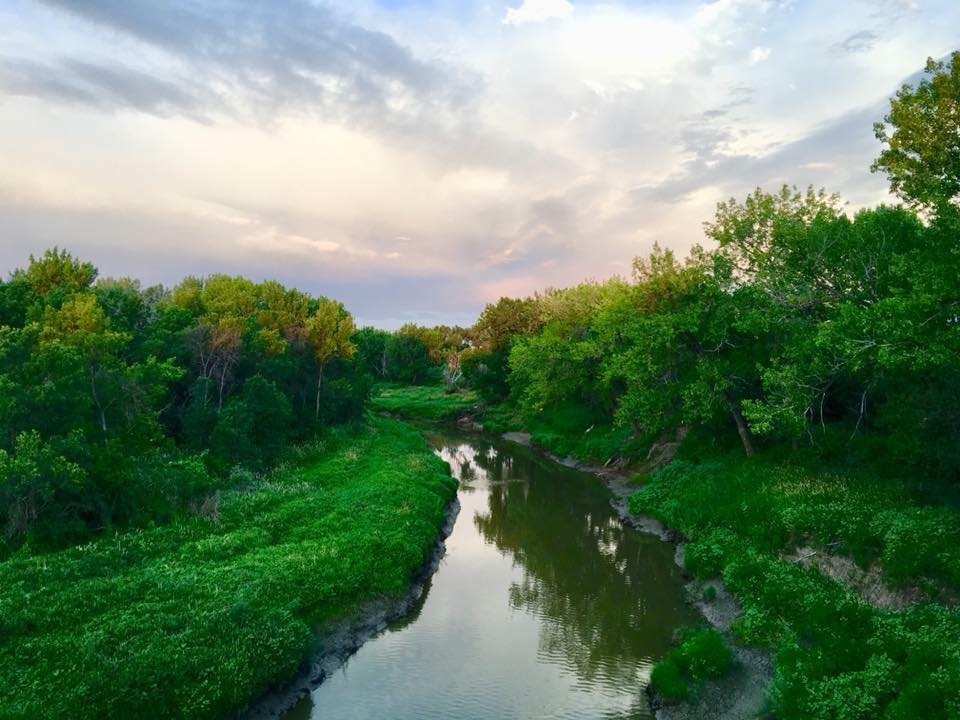
Photo by Pat Sinclair - Milk River Aug. 5th, 2018
The Milk River is 729 miles long and is the longest of the Missouri River's 59 primary tributaries. If it did not flow North into Canada, it would be considered the 17th longest river in the United States. It is formed in the Rocky Mountains on the eastern edge of Glacier National Park. The North and South forks of the Milk River then flow northeast through the Blackfeet Indian Reservation and ultimately merge just over the Canadian border. The mainstem Milk River continues 171 miles through Alberta, Canada before re-entering Montana north of Rudyard. 53 miles farther southeast the Milk River runs up against Fresno Dam, which was completed in 1939. This Dam forms what is presently known as Fresno Reservoir. From Fresno to the Vandalia Diversion Dam, which was completed in 1917, represents another 318 miles of river. This vast stretch includes both the Paradise Diversion Dam near Chinook and the Dodson Diversion Dam. The Dodson Dam, which was completed in 1910, conveys water for irrigation purposes and for storage into what is presently known as Nelson Reservoir. Below Vandalia Diversion Dam, for its last 120 miles, the Milk becomes very narrow with well-developed trees along its banks, a deeper habitat, as well as the occasional riffle.
The river’s most important contribution to the area’s fishery resource is its alliance with the Missouri River. In its lowermost 73 miles, the Milk River provides critical spawning habitat for native species of the Missouri River, such as the Blue Sucker, Channel Catfish, Freshwater Drum, Paddlefish, Sauger, Shorthead Redhorse, and the Shovelnose Sturgeon. In total, 41 different fish species roam the "Mighty Milk", but none are more prominent than the Channel Catfish. The Milk River is the home to the current state record Stone Cat and has previously held the state record Channel Cat. The Stone Cat, a 0.54 lb. beauty, was caught by Dale Bjerga near Havre on June 16th, 1996. The state record Channel Cat, broken in 1984, was a 23lb. 4 oz. giant caught by Larry Hamilton in 1980.
The Milk is very volatile due to it's contracted use for irrigation purposes and often times fish growth is dictated by flow and water levels. Since the early 2000's, with increasingly wet years throughout Canada and Northern Montana, water has been great on the Milk River and the native Channel Catfish has thrived accordingly. It is now reasonable to catch a dozen cats in the 2 to 4 lb. range, and have a great shot at one over 6 lbs. on a typical afternoon outing. The average Channel Cat on this body of water has increased from around 1.5 lbs. to 2.5 lbs. since the turn of the century and a 10 lb. Cat on the lower Milk is considered a "trophy". It is possible for a seasoned angler with knowledge of the area and small river catfish tendencies to land 30+ lbs. on five fish in a single evening. This 6 lb. average would have been unheard of 25 years ago.
This body of water is most accessible above Vandalia Diversion Dam and during average stream flows it is even navigable by prop boat for a 27 mile stretch of river throughout the "Hinsdale section". There is a concrete ramp at Milk River Park in the community of Hinsdale with a public dock, camping amentities, and bathoom facilities. Below Vandalia Dam, a jet boat is nearly a necessity with access at only farm and ranch crossings, irrigation pump sites, or via the mouth by way of four lower Missouri River ramps below Fort Peck Dam.
There are twelve "feeder" creeks downstream of Nelson Reservoir. Many of which can house Cats at different times of the year. Most notably, Frenchman Creek and Beaver Creek, where fishing is often superb during pre-spawn and cats can grow into the low teens.
This river is also host to the annual Milk River Catfish Classic held in Glasgow, MT on the first Saturday of every June.
Above Information from Montana Cats Staff.
"The water of this river possesses a peculiar whiteness, being about the colour of a cup of tea with admixture of a tablespoonfull of milk. from the colour of it's water we called it Milk River." - Meriwether Lewis May 8th, 1805.
